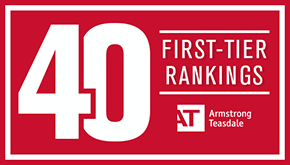IRS Issues Detailed FAQs on the Employee Retention Credit under the CARES Act
Last week, the Internal Revenue Service (IRS) issued much anticipated guidance on the scope of the Employee Retention Tax Credit established under the Coronavirus Aid, Relief, and Economic Security Act (CARES Act) through a comprehensive list of Frequently Asked Questions (FAQs).
The Employee Retention Tax Credit gives eligible employers a fully refundable tax credit equal to 50% of their employees’ qualified wages and health plan costs up to $10,000, for a maximum tax credit of $5,000 per employee. Wages paid after March 12, 2020, and before January 1, 2021, may be eligible for this credit.
Eligible Employers
Employers of any size may be eligible for the Employee Retention Tax Credit if the employer carries on a trade or business during 2020 and the employer either:
- fully or partially suspends operations during 2020 due to orders from an appropriate governmental authority limiting commerce, travel or group meetings (for commercial, social, religious or other purposes) due to COVID-19; or
- experiences a significant decline in gross receipts during a calendar quarter in 2020.
The Employee Retention Tax Credit is available to tax-exempt organizations but not to governmental employers. Also, an employer that receives a loan under the Paycheck Protection Program (PPP) (or is part of an affiliated group of companies any member of which receives a PPP loan) may not claim the credit.
Limits on an Employer with an Essential Business. Most notably, and somewhat surprisingly, the IRS guidance specifically provides that an “essential business” that is permitted to continue operations under a governmental order is generally not considered to have a full or partial suspension of operations. Instead, an employer with an “essential business” or potentially any employer within its aggregated group may generally only qualify for the credit if the employers experience a significant decline in gross receipts or qualify under other limited exceptions described below.
1. Suspension of Operations through Governmental Order
In order to qualify for the Employee Retention Tax Credit due to a suspension of operations, an employer must fully or partially suspend operations due to a governmental order, proclamation or decree from a federal, state or local government that limits commerce, travel or group meetings due to COVID-19 so as to impact the employer’s business. The IRS provides the following examples of governmental orders:
- an order from a mayor providing that all nonessential businesses must close;
- a state emergency proclamation requiring that residents shelter-in-place, other than residents who are employed by an essential business, who may travel to work; or
- a curfew imposed by a local official.
If an employer voluntarily suspends operations or reduces hours, the employer cannot claim that the business has incurred a full or partial suspension of operations caused by a governmental order. However, if the voluntary suspension results in a decline in gross receipts, that decline may provide a separate basis for claiming the credit, as discussed in more detail below.
Limited Exceptions for Loss of Suppliers or Limited Working Hours. As described above, an employer with an “essential business” will be deemed to have incurred a full or partial suspension of operations only in very limited circumstances. If a governmental order causes suppliers to be unable to deliver critical goods or materials, and this disruption in the supply chain causes a full or partial suspension of operations for an essential business, the employer with an “essential business” may pursue the Employee Retention Tax Credit. In addition, if a governmental order requires the employer with an essential business to reduce its normal working hours, and such reduction causes a partial suspension of operations, the employer may be considered to have a suspension of operations for purposes of the credit.
Office Closure. The IRS clarified that an employer that is required to close its workplace, but that can continue operations by having employees telework from home, is not generally considered to have a suspension of operations. If the workplace is closed for certain purposes but may remain open for other purposes, the purposes affected by the closure may cause a partial suspension of operations.
Aggregated Group with an Essential Business. If an employer with a nonessential business is required to partially or fully suspend operations due to a governmental order but it is a member of an aggregated group where certain members are essential, the IRS guidance is convoluted on how or whether such an employer can qualify as having a partial or full suspension of operations. In that case, an employer should consider seeking advice of legal counsel before claiming the Employee Retention Tax Credit.
2. Significant Decline in Gross Receipts
An employer has a significant decline in gross receipts in the first calendar quarter in 2020 in which the employer’s gross receipts are less than 50% of the employer’s gross receipts from the same calendar quarter in 2019. The employer’s significant decline in gross receipts continues until the first day of the calendar quarter in 2020 after the quarter in which gross receipts are greater than 80% of gross receipts for the same calendar quarter in 2019.
Gross receipts are calculated under Section 448(c) of the Internal Revenue Code of 1986, as amended (Code) and include total sales, all amounts received for services, and income from investments and incidental or outside sources. An employer does not have to show that the decline in gross receipts was caused by COVID-19. However, when determining whether an employer has had a significant decline, the gross receipts of all entities in the aggregated group are considered together. Special rules apply for new businesses and businesses acquired during 2020, and the IRS indicated that it intends to issue additional rules to explain how this test applies to tax-exempt entities.
Qualified Wages
Qualified wages are wages as defined in Section 3121(a) of the Code, which are amounts subject to FICA tax withholding, and qualified health plan expenses allocable to the wages. Qualified wages are not reduced by the employer’s or employee’s share of FICA taxes or federal income taxes withheld from the wages.
For large and midsize employers that averaged more than 100 full-time employees during 2019, qualified wages are wages paid to employees who are not providing services during a full or partial suspension of business or a period of significant decline in gross receipts. For small employers that averaged 100 or fewer full-time employees during 2019, qualified wages are any wages paid to employees during such a period of suspension or significant decline in gross receipts. The FAQs contain detailed rules regarding determining the number of full-time employees.
For large or midsize employers that averaged more than 100 full-time employees during 2019, the FAQs clarify that the Employee Retention Tax Credit may be available for hours or time during which employees do not perform services. An employer may use any reasonable method to determine the hours for which the employee is not providing services. However, an employer is required to exclude amounts paid to employees under existing leave policies, such as vacation, sick days or paid time off and severance payments. Also, amounts paid to certain individuals who are related to an individual who owns more than 50% of the business are not qualified wages. Wages paid pursuant to the Emergency Family and Medical Leave Expansion Act (EFMLEA) or the Emergency Paid Sick Leave Act (EPSLA) cannot be counted for the Employee Retention Tax Credit, and an employer may not take the credit for wages paid to an employee if the employer receives a Work Opportunity Tax Credit with respect to the wages for that employee.
The IRS included several FAQs which detail how qualified health plan expenses are calculated. These rules are very similar to the rules issued by the IRS for calculating qualified health plan expenses under the EFMLEA and the EPSLA. Notably, the IRS clarified that wages must be paid to employees in order to also claim the Employee Retention Tax Credit for qualified health plan expenses. If laid off or furloughed employees are not paid, but their health plan coverage is continued, no credit is available. Wages, even if reduced, must be paid in order to have wages to which the qualified health plan expenses may be allocated.
Claiming the Tax Credit
Total qualified wages should be reported on the quarterly Form 941. Qualified wages for the first quarter of 2020 (those paid after March 12, 2020) should be reported on the second-quarter Form 941. An eligible employer may fund the qualified wages by retaining withheld federal employment taxes that are otherwise required to be deposited with the IRS or requesting an advance on Form 7200.
Employee Retention Tax Credits are not included in the employer’s gross income. However, the employer’s aggregate deductions are reduced by the amount of the credit received.


































